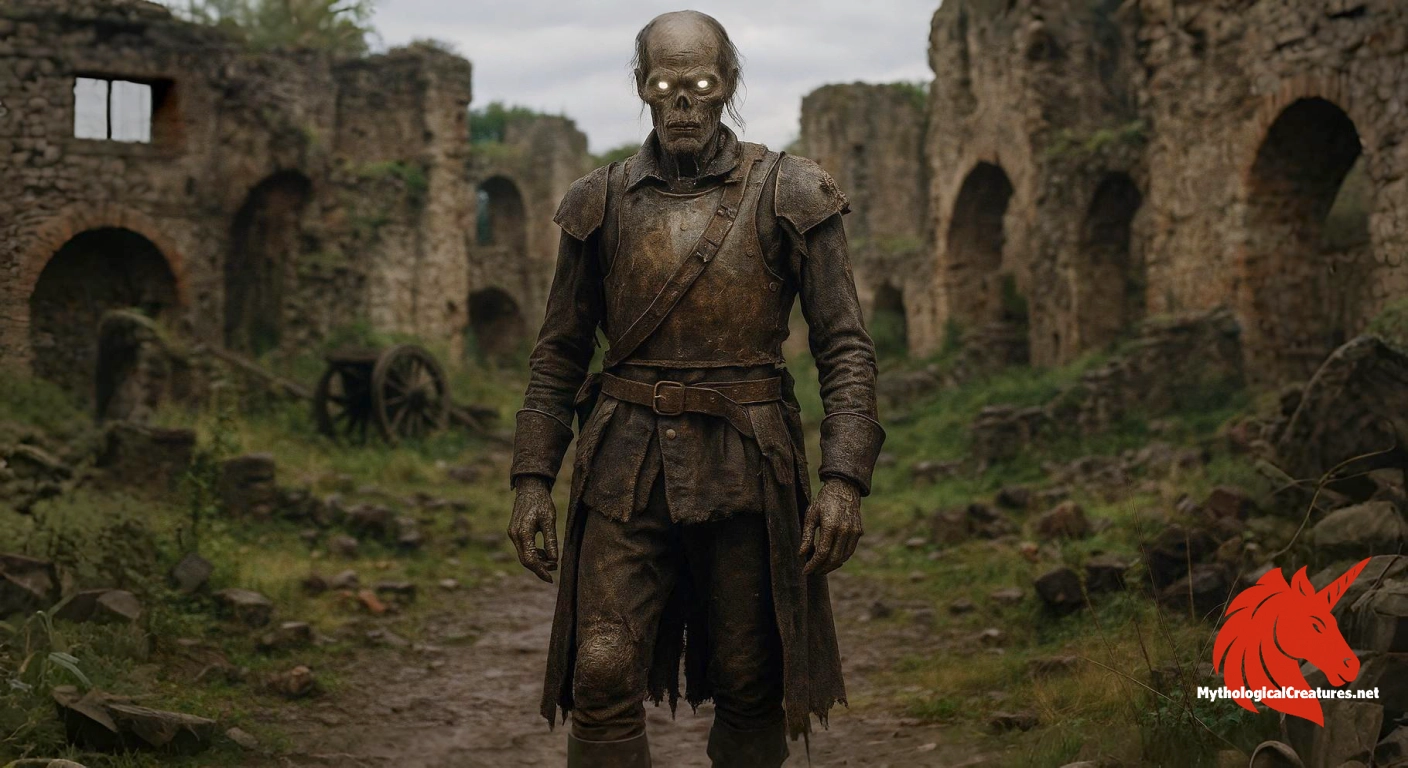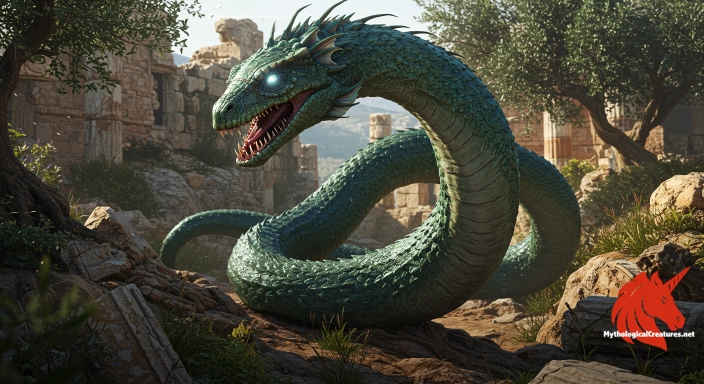Fext: The Fext is a mythical undead creature from Slavic folklore, emerging during the turbulent Thirty Years' War.

Fext
Fext - Represents the terror of war and the paradox of invincibility with a single, peculiar vulnerability.
Origins & First Encounters
The Fext occupies a unique place in Slavic myth, emerging from the chaotic shadows of the Thirty Years' War in 17th-century central Europe. Its origin is intertwined with the devastating and transformative conflicts of the period, and this creature embodies the terror and respect that war instilled in the people of the time. Tales of the Fext have been passed down through generations as a symbol of undying military might and the supernatural. The lore depicts it as an undead entity, a remnant of a life force that refused to fade even in the face of incessant battle. Beyond mere folklore, the Fext resonates with a cultural symbolism that blends human resilience with the eerie persistence of an ethereal warrior. The myth illustrates how extreme circumstances can birth legends that defy mortal limitations. Legends often assert that while the Fext is impervious to most forms of conventional injury, it carries an unusual vulnerability that invites further mystery. Its story provides a window into the fears, hopes, and the turbulent spirit of a time when war redefined the human experience.
Source Texts & Tale Variants
Early chronicles from central Europe record murmurs of the Fext during the era of the Thirty Years' War, where grim accounts slowly evolved into myth over time. Oral traditions played a pivotal role in moulding the narrative, with stories of undying generals and cursed warriors being told around dimly lit hearths and in crowded market squares. Various folk ballads and minor historical texts reference a mysterious figure whose invulnerability marked him as more than mortal. Some texts hint that he was a cursed remnant of warfare, a byproduct of mankind’s darkest hours, while others depict him as a near-legendary general blessed with supernatural endurance. Alternative variants of the story sometimes portray the Fext as a cursed soul condemned to wander the battlefields, symbolically representing the perpetual cycle of violence and retribution. A number of later reinterpretations emerged in local lore, each adjusting specific details to better suit the cultural and social contexts of its tellers. Manuscripts from lesser-known local scribes also provide brief mentions, elevating the creature's status in regional mythologies. Over the centuries, the blend of documented reports and shadowy folklore has enriched the creature’s myth, allowing multiple story variants to exist concurrently.
Form & Powers
The Fext is often depicted as a spectral figure with a pallid, almost corpse-like complexion that hints at its undead nature. Observers have recounted that its eyes glow with an otherworldly light, suggesting both torment and a relentless will to battle. Its body, though decayed, possesses an unnatural vigour and an imposing presence that instills fear even among seasoned warriors. Descriptions vary widely, with some accounts presenting it as towering above ordinary men, while others see it as a lean, mysterious silhouette cloaked in the remnants of tattered military regalia. The creature’s appearance is frequently marked by deep scars and mysterious runic marks that seem to echo the memories of ancient conflicts. There are also mentions of spectral armour or vestiges of a once-regal uniform that now serve as mottled fragments of a bygone era. A particularly striking feature is its legendary invulnerability, said to be so complete that conventional bullets leave little more than superficial marks on its otherworldly flesh. Despite its intimidating form, subtle details such as a slight tremor in its posture or the faint sound of clashing metal in its steps suggest an eternal struggle between life and death. The overall imagery created by these descriptions reinforces the idea of an undying warrior forged in the crucible of war.
Regional Faces
The myth of the Fext has taken on varied forms as it spread across different Slavic regions, each adapting the narrative to reflect local traditions and historical experiences. In some areas, particularly in the rural expanses of Eastern Europe, the Fext is depicted less as a revered general and more as a spectral omen that haunts the forgotten battlefields. Central European interpretations retain a sense of martial dignity, often associating the creature with legendary military leaders whose fates blurred the lines between myth and reality. In neighbouring cultures, the Fext has merged with local legends of restless spirits and undead guardians, sometimes rebranded under different names that highlight its supernatural essence. Stories circulating in regions such as Ukraine, Poland, and parts of the Balkans suggest slight alterations in its vulnerabilities, with some local versions replacing glass bullets with enchanted shards of crystal or silver. Variations in the narrative also extend to moral attributes, with some traditions portraying the Fext as a protective spirit while others emphasise its role as a harbinger of inevitable doom. The differences in descriptions reflect the diverse socio-political and cultural backdrops against which these legends evolved. Folk storytellers have adapted the creature's image to address the unique conflicts and collective memories of their communities. As a result, each retelling of the Fext’s myth carries a regional flavour that highlights the rich tapestry of Eastern European folklore.
Cultural Parallels
The figure of the Fext shares intriguing similarities with other undead warriors found across global mythologies, inviting comparative reflections with legends such as the Norse Draugr. These spectral beings are often depicted as restless remnants of warriors, whose undying nature serves as a cautionary symbol of unresolved conflict. In this regard, the Fext resonates with the archetypal motif of the cursed soldier, similar to the revenants of Medieval Europe who are doomed to roam the battlefields. Like many of these figures, the Fext embodies a blend of invincibility and vulnerability—a trait that has garnered fascination in both ancient and modern storytelling. Its unique susceptibility to glass bullets further distinguishes it from its counterparts, suggesting a symbolic message that even the seemingly invincible have hidden frailties. The pervasive theme of a singular weakness amidst overwhelming strength parallels modern narratives in superhero lore, where immense power is often counterbalanced by a critical vulnerability. Comparative analysis also reveals that undead warriors are frequently used to reflect on the costs of violence and the eternal nature of conflict. As such, the Fext functions as a cultural mirror, echoing similar mythic structures in diverse traditions while maintaining a distinctly Slavic character. Through this lens, the creature is not only an embodiment of martial immortality but also a repository of shared human concerns about mortality, legacy, and the nature of warfare.
Legacy & Modern Evolution
The evolution of the Fext myth mirrors the shifting perspectives on war and immortality from its origins to contemporary times. Its depiction has transitioned from a terrifying symbol of the past’s endless bloodshed to a more complex representation in modern literature and film. Over the centuries, the creature’s image has been reinterpreted in art and popular culture, increasingly portrayed as a tragic figure burdened by eternal combat rather than a mere supernatural anomaly. In recent times, the Fext has resonated with audiences as a metaphor for the paradoxical nature of invulnerability, where immense power is always shadowed by an underlying weakness. This renewed interest has spurred reinterpretations that blend historical realism with fantasy, exploring themes of human resilience and the curse of perpetual conflict. Modern adaptations often highlight its unique vulnerability—being defeated by glass bullets—as a poetic reminder that even the mightiest eventually succumb to unexpected forces. In academia and cultural studies, the Fext has become a subject of interest for its rich symbolic layers and its capacity to encapsulate the human struggle with mortality and memory. As historical narratives continue to be re-examined, the Fext remains a potent emblem of the transformative power of myth, inviting contemporary audiences to reflect on both the glory and the tragedy of everlasting warfare. Its enduring legacy serves as a bridge between the brutal realities of past conflicts and the imaginative realms of modern storytelling, ensuring that the myth of the undead general lives on in new and thought-provoking forms.
Interesting Fact
An interesting aspect of the Fext is its exclusive vulnerability to glass bullets, a detail that symbolically contrasts its overwhelming invincibility and contributes to its enigmatic legacy.
Quick Creature Info
Features:
Our Mythic Legendary Rating:

Habitat:
Supernatural Powers:
Physical Attributes:
Abilities:
Behavior:
Weaknesses:
Lore:
References
Discover Another Mythical Legend You May Not Have Heard Of?
Uncover the mysteries of ancient folklore and expand your knowledge of legendary beings from cultures around the world.
Dare to Meet the Delphyne....
Mythical Disclaimer: The images and data on this site are derived from various historical and literary sources, but we have found that many myths often have multiple versions and interpretations across references, sometimes contradictory. As a result, these creature depictions are artistic interpretations—imaginative blends of folklore, legend, and a dash of AI guesswork. Because creature descriptions vary widely, our illustrations and accompanying information represent our best effort to honor mythology while bridging creative gaps. Enjoy these interpretations—just remember, we've done our best to respect the stories and validate available data, but in the realm of mythology, details often shift, imagination leads the way, and nothing is ever set in stone!
Curated by the Mythological Creatures Team (rev. May 2025)
